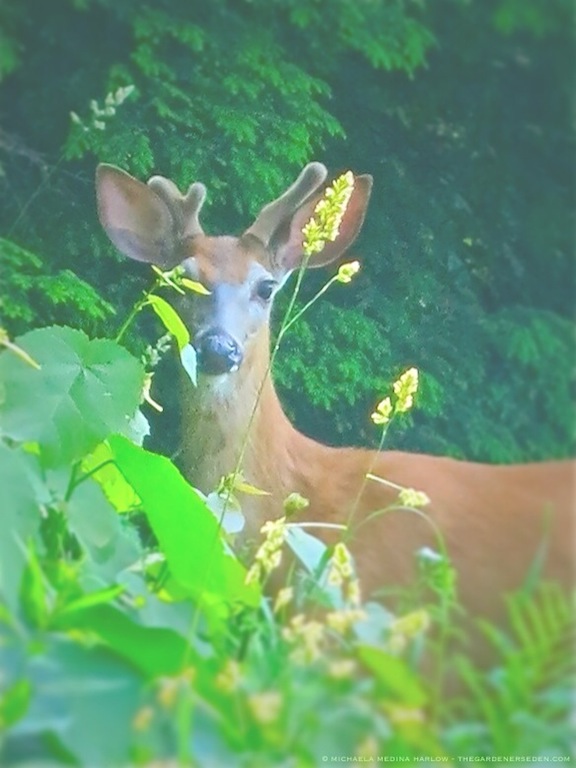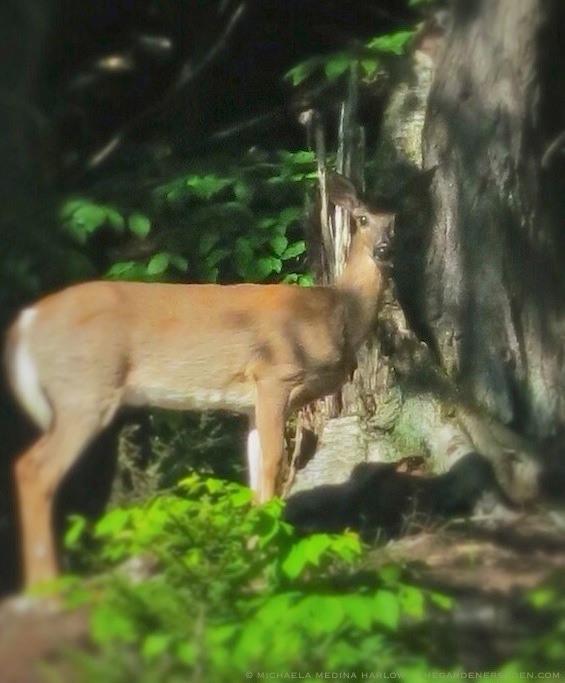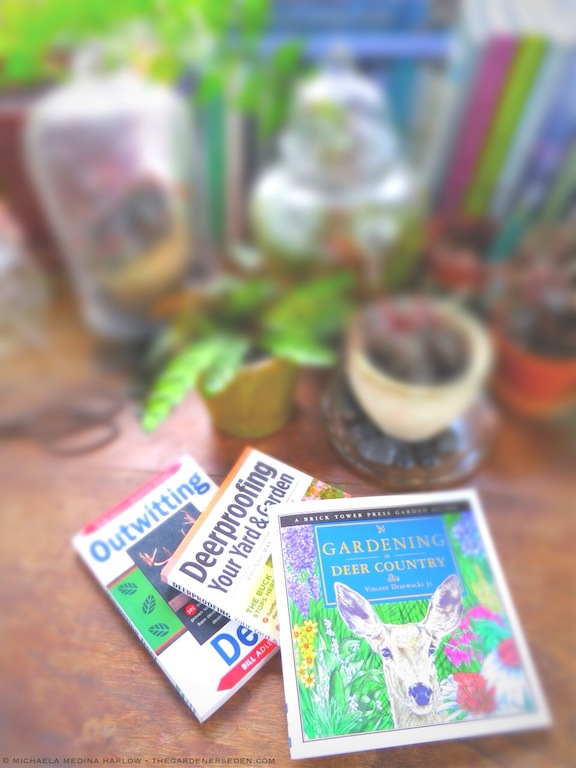Oh Dear, Oh, Deer in the Garden: Dealing with a Big, Brown-Eyed Problem
 Â Peek-a-Boo: Playing Hide & Seek with a Young, White Tailed Buck in My Neighborhood
 Peek-a-Boo: Playing Hide & Seek with a Young, White Tailed Buck in My Neighborhood
Handsome fella, isn’t he? Of course he is. There’s no denying the beauty of this graceful, tawny, brown-eyed creature. He’s just gorgeous… Until he gets into your garden. Then, much like Dr. Jekyll, beautiful Bambi turns into Mr. Hyde. A single white tailed deer can wipe out an entire vegetable garden and denude a lush landscape, overnight. In fact, when it comes to gardening challenges, I can’t think of a more difficult or devastating problem.
Short of completely enclosing a property with a 8-10′ high fence, all deer management strategies should be considered exactly that: strategies, not fail-proof solutions. Before designing and planting a dream garden in deer country, fence construction is an absolute must. However, where fencing isn’t an option, I have discovered a few ways a gardener can make the landscape a bit less enticing to those long-legged, midnight mowers. Here are a few that I’ve found effective over the years . . .
1) Plant aromatic plants and/or species that are toxic to or repel deer and rodents at the perimeter of the garden. Daffodils and Ranunculus are both examples of plants toxic to deer. When they encounter wide drifts of these plants, they will likely move on to more edible pastures. Deer also dislike many commonly cultivated herbs; particularly Lavender, Sage, Basil, Rosemary, Thyme and Yarrow. Surrounding a potager with herbs may repel deer before they find the tasty beans and lettuce at the center of your kitchen garden.
2) Surround your property with prickly and fuzzy plants. Thorny trees and shrubs —such as Roses, Raspberries, Hawthorn, Quince— tend to be less attractive to grazing deer. They may nibble, but after a few sharp stabs, they usually wander off. Consider a hedge of prickles around your property line or potager edge. Fuzzy plants also tend to be less palatable to deer. Black-eyed Susans, Lambs Ears and other wooly plants are not the first choice on Bambi’s menu.
3) Keep deer favorites —particularly Hosta, Azalea, Daylilies, vegetable plants and fruit trees— toward the center part of your garden. Surround the more vulnerable plants with those mentioned above, and consider protecting these innermost areas with some form of additional defense (spray repellents, netting, electric fencing, etc).
 White Tailed Doe at the Edge of My Forest
White Tailed Doe at the Edge of My Forest
4) If deer are a serious ongoing and/or increasing problem in your area —and fencing isn’t an option— consider slowly adjusting and reducing the menu options in your backyard. Seek out plants that are less palatable to deer, and plant more of these in your garden. Although deer will eat anything when desperately hungry, they tend to snub gardens that are surrounded by hedges or layered plantings including some of the following trees/shrubs: Hinoki Cypress, Kousa Dogwood, Ginko, Green Ash, American Holly, Star Magnolia, Sourwood, White Spruce, Norway Spruce and Colorado Spruce, Red Pine, Black Locust, Sassafras, Boxwood, Inkberry, Spirea and Western Arborvitae. In addition, deer may nibble, but will usually walk on by the following perennial garden plants, bulbs and ground covers: Yarrow (Achillea millefolium), Monkshood (Aconitum), Alyssum, Columbine (Aquilegia), Artemisia, Asters. Astilbe, Lady’s Mantle (Alchemilla mollis), Wild-Blue Indigo (Baptisia australis), Boltonia, Fairy Candles (Actaea simplex & A. racemosa), Peony, Foxglove (Digitalis), Jacob’s Ladder (Polemonium reptans) , Meadow Sage (Salvia), Hellebore, Loosestrife (Lysmachia), Beebalm (Monarda), Catmint (Nepeta), Russian Sage (Perovskia), Yucca, Black-eyed Susan (Rudbeckia), Meadow-Rue (Thalictrum), Foamflower (Tiarella), Speedwell (Veronica), Scabiosa, Ginger (Asarum), Bearberry (Arctostaphylos), Bugle Weed (Ajuga), Lily-of-the-Valley (Convularia majalis), Snow-in-Summer (Cerastium), Dead Nettle (Lamium), Creeping Juniper, Pachysandra, Lungwort (Pulmonaria), Squill (Scilla), Summer Snowflake (Leucojum), Winter Aconite (Eranthis), Snowdrops (Galanthus), Grape Hyacinth (Muscari), Sedum, Hens-and-Chicks (Echeveria), Myrtle (Vinca), Potentilla, Lavender-Cotton (Santolina), Cotoneaster, Bergenia, Sweet Woodruff (Galium), Ferns, Daffodils (Narcissus), Allium and Barrenwort (Epimedium). This is an abbreviated list containing the more deer-resistant plants. Many more can be found in the resources listed below.
5) Experiment with organic, commercial spray repellents or homemade hanging repellents. I find some of these are more effective than others. Plantskydd, and Bonide Repels-All —both organic— have worked for me when strategically sprayed and repeat applied after rain. There are two downsides to these products: they stink and they can be expensive to use in the long-run. Bars of soap and baggies filled with pet or human hair can be effective within a narrow range of space, and for a short time. Hanging these at the perimeter of a vegetable garden can be a bit of a deterrent, but I wouldn’t gamble my harvest on it!
6) Walk your dog, or invite neighbors to walk their pooches at the perimeter of you garden on a regular basis. Deer fear the canine scent, and regular urine marks will lead them to believe danger lies within your garden. The key here is consistency. Bottled coyote urine can also be used if no dogs are available, but again these spray-application deterrents can be both expensive and unpleasant to use.
7) Fencing. Yes, I will say it again. Although the initial cost is high, fencing is the most effective method for controlling deer. A fence must be 8-10 feet or taller, in order to protect a garden from deer. If not solid, the fence should have wire mesh or netting between the posts to keep deer from climbing through cross bars. Electric fencing —including solar-powered electric— can be an excellent barrier option for smaller plots —particularly vegetable gardens and small fruit groves— if properly installed and maintained. Some gardeners have had success with motion-detection fences. These devices usually trigger a sound/light combination or blast of water. I have not tried motion detection devices for deterring deer, and clearly, there’s a limit on where and when they can be used.
 Some helpful guide books for gardeners challenged by deer:
Some helpful guide books for gardeners challenged by deer:
Gardening in Deer Country (contains a recipe for homemade deer repellent), Deerproofing Your Yard & Garden, Outwitting Deer and Deer in My Garden.
Photography & Text â“’ Michaela Medina Harlow/The Gardener’s Eden. All images, articles and content on this site (with noted exceptions), are the original, copyrighted property of The Gardener’s Eden and may not be reposted, reproduced or used in any way without prior written consent. Contact information is in the left side bar. Please do not take my photographs without asking first. Thank you!Â
Do you enjoy The Gardener’s Eden? You can help support this site by shopping through affiliate links. A small percentage of each sale will be paid to this site, helping to cover web hosting and maintenance costs. Thank you so much for your support!

